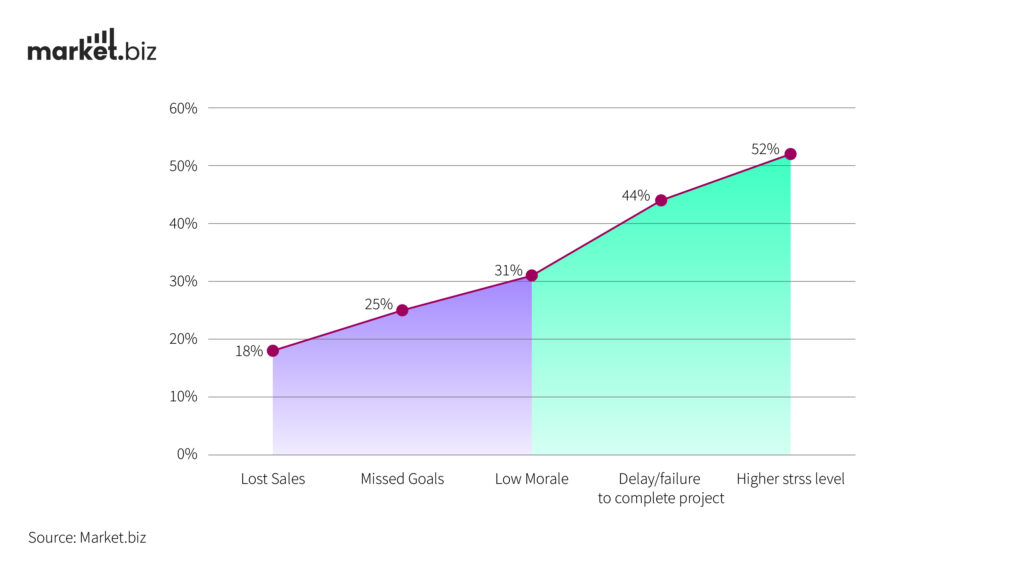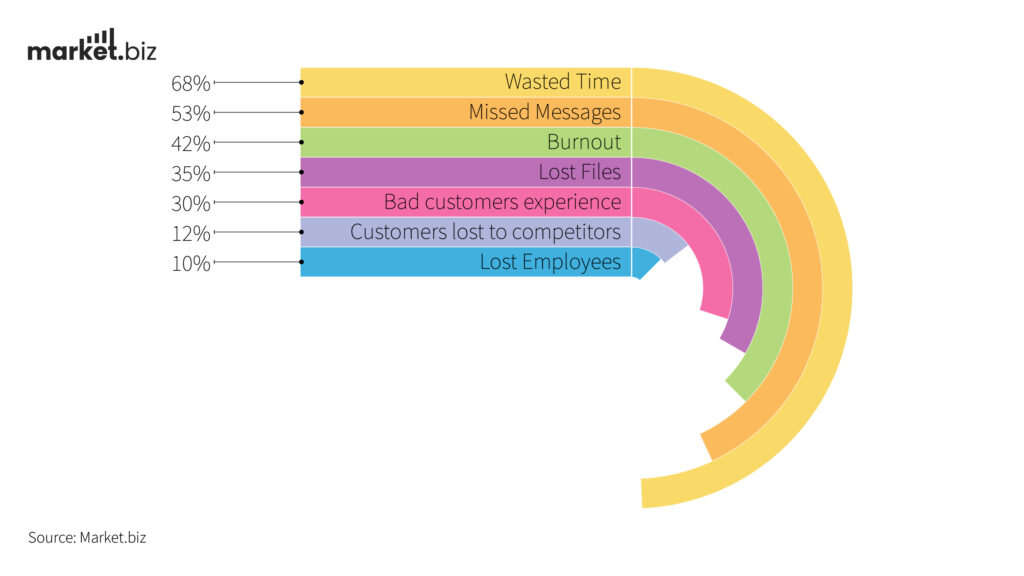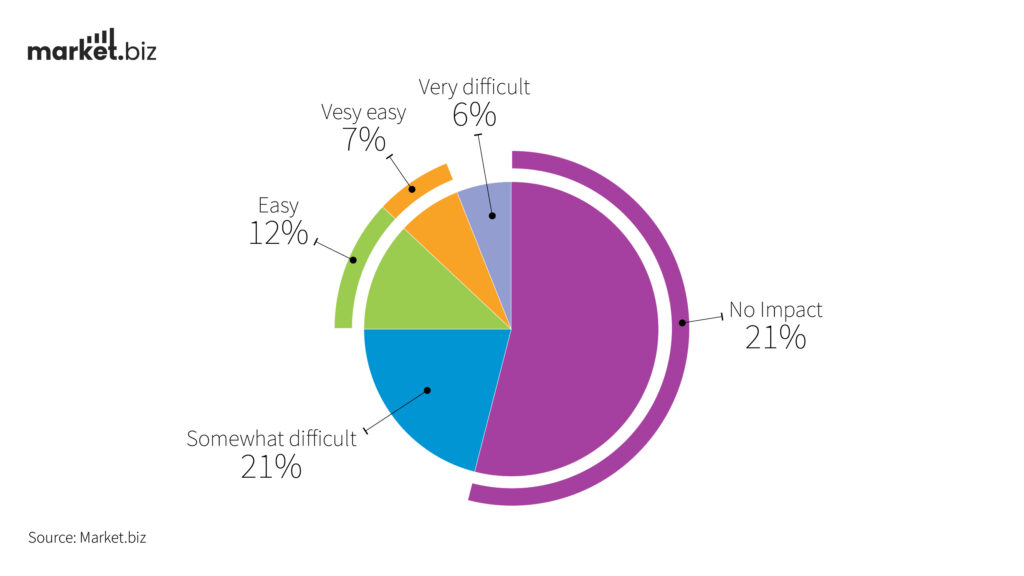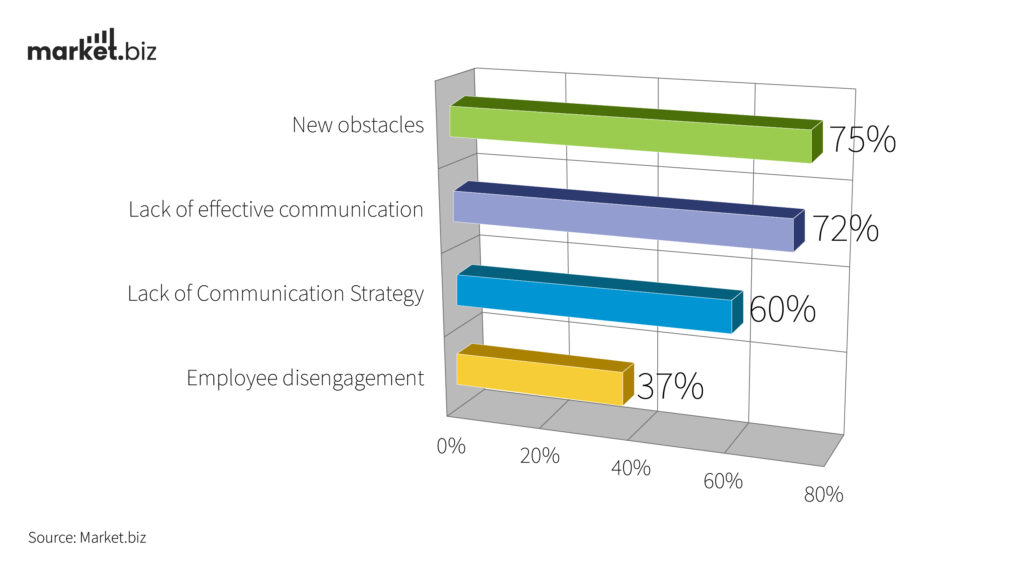Introduction
Effective communication in the workplace is crucial for fostering collaboration and enhancing productivity. Organizations with strong communication practices are 25% more likely to be productive. 86% of employees and executives cite a lack of collaboration and ineffective communication as key causes of workplace failures. Furthermore, 75% of employees report that communication has a direct impact on their job satisfaction. With 57% of employees stating that better communication can reduce misunderstandings, it’s clear that improving workplace communication is essential for organizational success.
Editor’s Choice
- Companies with strong communication practices are 25% more likely to be productive, with 86% of employees citing ineffective communication as a major cause of workplace failures.
- 75% of employees report that communication directly influences their job satisfaction, with 57% stating better communication reduces misunderstandings.
- Poor communication costs companies significantly, with businesses of over 100,000 employees losing $62.4 million annually due to miscommunication.
- The number of global internet users has surged, with 4.57 billion active users as of 2023, underscoring the importance of digital communication tools.
- 75% of workers prefer visual aids like infographics or videos in internal communications, enhancing message retention by 40%.
- 50% of remote workers prefer using messaging apps for communication, highlighting the increasing reliance on digital platforms in remote work.
- 70% of employers believe communication skills are more important than technical skills, with 80% ranking them as crucial for project success.
- English, spoken by 1.5 billion people, is the most widely used business language globally, followed by Mandarin and Spanish, which are key for international trade.
- Email remains the most widely used tool for professional communication, with over 4 billion active users, while platforms like Slack and Microsoft Teams are vital for team collaboration.
- 86% of knowledge workers report communication challenges at work, with issues like delayed responses and message misunderstandings being the most common.
- Miscommunication leads to lost time, costing U.S. businesses approximately $1.2 trillion annually, with poor communication accounting for a 15% decline in productivity.
- Effective communication improves productivity, with 72% of business leaders and 52% of workers reporting boosted team productivity through better communication.
General Workplace Communication Statistics
- Conversation Worldwide, only 15% of workers are actively involved in their jobs, according to workplace statistics.
- Almost 74% of workers believe they should stay up to date on corporate news and updates.
- Nearly 9 out of 10 workers think their supervisors need to improve their communication abilities.
- Merely 13% of workers strongly concur that their leaders are communicating with the company in an effective manner.
- It is estimated that 69% of managers find it difficult to communicate with staff members.
- Three-quarters of workers believe that their company needs to collaborate more.
- Conversation Nearly 60% of businesses, according to workplace statistics, still require a long-term strategy for internal communication.
- 86% of workers believe that one of the main causes of workplace failure is inadequate communication.
- Regular company news updates from management increase employee motivation by 85%.
- Interaction Nearly 96% of workers believe that demonstrating empathy is essential to increasing employee retention, according to workplace statistics.
- 73% of actively disengaged employees and 56% of disengaged employees are searching for new employment.
- 69% of workers who had a positive on boarding experience are more likely to remain with a company for three years.
- Employee turnover is 50% lower in companies with effective communication.
- 89% of employees are more likely to recommend their employer to others when they work for a company that offers well-being programs.
- 31% of workers claim they never use their intranet, and only 13% use it every day.
- Compared to their peers, employees with greater knowledge perform 77% better.
Digital Communication Statistics
- In 2019, there were 13 billion internet users. Research on communication indicates a significant rise in internet users worldwide. The number of internet users increased from 3.2 billion in 2019 to 4.13 billion in 2019.
- There were 4.57 billion active users by June 2023, or 59% of the global population.
- There are 2.5 billion internet users every day, with the majority coming from Asia.
- There are roughly 333 million users in North America, 467 million in Latin America, and 727 million in Europe.
- Nearly 90.3% of North Americans use the Internet, according to Communication Statistics. The percentage of a nation’s population that uses the Internet is indicated by its internet penetration rate.
- The highest rate is 90.3% in North America and 87.2% in Europe. Asia has a rate of 59.5%, while Africa has a lower rate of 47.1%.
- China had 854 million internet users in 2019, making it the nation with the highest number of internet users.
- In contrast, there were 313 million internet users in the US, 560 million in India, and 63.54 million in the UK.
- Mobile devices are used by 91% of users to access the Internet. Nowadays, 91% of internet users access the internet, social media, and chat on smartphones or tablets.
- Every month, nearly 90% of internet users worldwide use social media. Each of the top six social networks has more than one billion monthly active users.
Effective Communication Methods
- 75% of workers prefer visual aids like infographics or videos to internal communications that are only text-based.
- From the beginning of the widespread use of remote workers, about 65% of businesses have increased their use of remote communication tools.
- In order to better manage their workflow and lessen meeting fatigue, 58% of employees prefer adaptive communication methods.
- 40% of workers think that team creativity and innovation are improved by frequent and transparent communication.
- Clear Written Communication is essential for avoiding misunderstandings, with 72% of employees indicating they rely on clear emails and memos for effective information sharing.
- Active Listening plays a crucial role in communication, with 85% of effective communicators emphasizing listening as key to understanding and resolving issues.
- Regular Team Meetings help ensure alignment, with 64% of companies holding weekly or bi-weekly meetings to keep teams on track.
- Visual Communication through infographics or charts increases message retention by 40%, making it a powerful tool for presenting complex data.
- Mobile Communication tools, like instant messaging apps, are favoured by 58% of employees for their convenience and speed in day-to-day communication.
- Social Media Communication is increasingly important for brand and internal engagement, with 65% of businesses using platforms like LinkedIn for professional interaction.
- Feedback Loops are vital for improvement, with 69% of organizations finding regular feedback sessions improve team performance and communication flow.
Cost of Bad Communication in the Workplace

- Miscommunication cost businesses with more than 100,000 employees $62.4 million annually.
- The cost of miscommunication is extremely high, regardless of the size of the business. After all, a small business could easily go bankrupt if it lost more than $400,000.
- Miscommunication costs businesses with just 100 workers up to $420,000 annually.
- Customer service is a problem for almost half of all businesses, costing them up to $75 billion annually.
- Workers spend up to 17 hours a week resolving ambiguous communications. This is particularly true for communications that employees can easily misinterpret, such as emails and texts.
- The average annual cost of miscommunication for each employee is $5,200.
- Business leaders believe their organizations waste 7.4 hours of productive time every week because of poor communication.
- The annual cost of miscommunication is approximately $625,300 for a company with 50 employees, $6.25 million for a company with 500 employees, and $125 million for a company with 10,000 employees.
- Poor communication results in lost time costs of $12,506 per employee annually on average.
- When it comes to lost work hours, miscommunication costs the US economy $1.2 trillion annually.
- In 2022, a 15% increase over the previous year, 43% of business leaders claimed that poor communication was the reason for a decline in productivity.
- Miscommunication impacts deadlines, according to 42% of leaders, and it raises expenses, according to 38%.
- Interaction According to workplace statistics, nearly 69% of workers claim that poor communication at work causes them to feel stressed.
- Poor communication cost 19% of company executive’s clients.

Remote workplace communication statistics
- Business executives use communication protocol 84% of the time, compared to 72% of knowledge workers.
- 49% of millennials believe that communication process allows them to accomplish more.
- In order to stay strategic and adapt to changing workplace dynamics, 37% of organizations said they intended to implement system and technology changes in 2024.
- Face-to-face and web calls dominated the usage of various communication channels, indicating that real-time broadcasts are the most successful.
- 62% of workers interact directly with co-workers in different time zones.
- Meeting communication accounts for 1–10 hours of 75% of remote workers’ workweek. Additionally, time is spent emailing someone who was absent from a meeting.
- 38% of remote workers prefer to be off camera during meetings, while 62% prefer to be on camera.
- 50% of remote workers say they prefer messaging apps for team or client communication. Meetings are preferred by 19% and email by 22% of respondents, respectively.
- While working from home, 40% of respondents said their work-life balance was very healthy, while 2% said it was very unhealthy.
- Even though they work remotely, 75% of remote workers said they feel a connection to their co-workers.
- According to 81% of remote workers, they check their emails after hours.
- 80% of business executives can provide specific instances of times when they felt stressed or anxious due to unclear communication.

Employer Perception of Communication Skills
- Approximately 70% of employers believe that communication abilities are more crucial than technical ones.
- The largest issue, according to 45% of employers, is the requirement for effective face-to-face communication skills.
- Nearly 80% of employers rank communication skills as the most crucial attribute in job candidates, according to communication statistics.
- More than any other quality, oral communication abilities are valued by 60% of employers.
- According to 80% of employers, effective communication is essential to project success.
- Nearly 53% of employers believe that listening skills are crucial for workers.
- According to 93% of employers, soft skills are just as important as technical skills, if not more so.
- Almost 72% of workers believe their managers could communicate better.
- According to 89% of employers, one of the biggest barriers to productivity is inadequate communication.
- According to about 88% of communication specialists, executive communication is a crucial ability.
- Communication skills are highly valued by 78% of HR professionals when evaluating job candidates.
- Communication skills are preferred over technical skills by 74% of employers.
Most used languages in business communication
Business languages for international teams
- English is the official language of major economies like the US, UK, and Canada, and it is spoken by more than 1.5+ billion people worldwide. It is essential for cross-border trade, negotiation, and communication.
- Mandarin, which is spoken by 1.1 billion people, is essential for reaching the enormous Chinese market, which leads the world in e-commerce, technology, and manufacturing.
- Spanish, which is spoken by 559 million people worldwide, is a vital language for trade in Latin America and the US.
- Doing business in Europe, especially in industrial powers like Germany, Austria, and Switzerland, requires knowing German. It’s significant in research and scientific circles as well.
- The importance of Arabic, which is spoken by 274 million people, is growing due to the expanding economies of the Middle East and parts of Africa.
- Access to established and developing markets in Africa, Europe, and Canada is made possible by the 300 million people who speak French worldwide.
- Japan is a great asset for companies looking to enter that market because of its innovation and technological dominance.
| Label One | Label two | Three | Four |
|---|---|---|---|
| English | 23.94 | 27 | 1.5+ billion |
| Chinese | 16.54 | 18 | 1.1+ billion |
| Spanish | 6.99 | 8 | 559.1+ million |
| Japnease | 5.01 | 6 | 123.4+ million |
| German | 4.91 | 5 | 133.2+ million |
| French | 3.44 | 4 | 309.8+ million |
| Arabic | 2.43 | 3 | 274+ million |
| Italian | 2.18 | 2 | 69.9+ million |
| Portuguese | 1.95 | 2 | 263.6+ million |
| Korean | 1.86 | 2 | 81.7 million |
Languages studied on Duo lingo in 2024
- English,
- Spanish,
- French,
- German,
- Japanese,
- Italian,
- Korean,
- Chinese,
- Portuguese, and
- Hindi.
Business languages in the US
- Spanish,
- Chinese,
- Tagalog,
- Vietnamese, and
- Arabic
Business languages in the UK
- English
- Polish — 1.1% of the population,
- Romanian — 0.8% of the population,
- Punjabi — 0.5% of the population, and
- Urdu — 0.5% of the population
Most Used Digital Communication Tools
- Email remains one of the most widely used digital communication tools, with over 4 billion active email users globally, highlighting its importance in professional communication.
- Slack is a leader in team collaboration, with over 18 million daily active users, providing real-time messaging and file sharing in work environments.
- Microsoft Teams has become a dominant tool for remote work, with more than 250 million monthly active users, enabling video conferencing and collaboration.
- Zoom saw rapid growth during the pandemic, with over 300 million daily meeting participants, making it a go-to for video conferencing and virtual meetings.
- WhatsApp is widely used for both personal and professional communication, with over 2 billion active users globally, offering messaging and voice/video calls.
- Google Meet has grown significantly in recent years, with over 100 million daily meeting participants, popular for its integration with Google Workspace.
- Trello is widely used for project management, with over 50 million users, providing an efficient way to manage tasks and collaborate visually.
- Skype still remains popular for international calls and video chats, with over 40 million active users, offering low-cost calling and instant messaging.
- Asana is used by over 100,000 organizations worldwide to manage tasks and track projects, streamlining team communication and workflow management.

Common Communication Challenges
- Effective internal communication is hampered by the fact that 60% of businesses lack a long-term communication strategy.
- Only 54% of businesses track the success of their workplace communication strategies.
- The majority of company executives (72%) acknowledge that during the past 12 months, their teams have struggled with effective communication.
- Communication problems at work are reported by 86% of knowledge workers. Not getting timely responses (49%), making sure messages are understood (37%), and understanding received messages (33%), are the main difficulties.
- Compared to knowledge workers (45%), business leaders (72%) are more likely to recognize communication difficulties with external parties. Almost three-fourths of leaders admit that their teams have trouble communicating consistently and clearly.
- According to 30% of respondents, it has gotten harder to communicate with clients and co-workers in the past 12 months. In an effort to overcome new obstacles, 75% have also implemented a new tool to enhance business communication in the last 12 months.
- But only 20% of leaders agree with 44% of workers who believe that leaders avoid difficult conversations.
- Although employees spend half of their workweek communicating, up to 86% of those surveyed claim to have communication problems.
- According to 37% of those surveyed, the largest obstacle to internal communication is employee disengagement.
- Improvement of communication takes up more than half of the working hours for only 18% of internal communicators.
- It’s difficult for nearly half of top leaders (59%) to adapt their communication style to the demands of remote work and expanding teams. For 42% of respondents, setting aside time to produce significant communications is difficult.
According to 85% of executives in 2024, internal communications are useful and pertinent. Just 45% of workers concur. Similarly, only 47% of employees concur with 83% of leaders that their internal communications are engaging and clear.
img
Benefits of Communication in Workplace
- Workers are five times more productive when they feel included in workplace communications.
- Effective communication has boosted team productivity, according to 72% of business leaders and 52% of knowledge workers.
- According to 60% of company executives, good communication boosts employee confidence. Of the 1,001 knowledge workers polled, 56% said it also improved their level of job satisfaction.
- Employee engagement increased by 2% from 20% in 2020 to 23% in 2022 as a result of effective communication.
- Compared to their peers, engaged employees are 17% more productive.
- 79% of workers are more likely to stick around if they feel appreciated, cared for, and supported at work.
- 74% of workers said they would prefer to work for a reliable company that involves them in decisions and communications.
Consequences Poor Communication
- A Grammarly report claims that 34% of workers are less satisfied with their jobs as a result of poor communication, which also raises stress and employee attrition.
- 30% of workers acknowledge that their professional confidence has been damaged by misunderstandings.
- 43% of workers were somewhat or extremely likely to change jobs in 2023 due to inadequate workplace communication, per Microsoft’s 2022 work index.
- According to 48% of Gen X’s, stress would affect how well they perform at work, and 43% acknowledged that they would become disinterested in working for a company if they saw employees who were obviously unhappy.
Conclusion
To sum up, clear and effective communication is essential for business success. Companies with strong communication are 25% more productive, while 86% of employees say poor communication is a major reason for workplace failures. As digital communication grows, tools like email, Slack, and Microsoft Teams have become key to team collaboration, with 4.57 billion people using the internet by 2023.
Miscommunication costs U.S. businesses up to $1.2 trillion a year, making it clear that improving communication is vital. Employers are increasingly valuing communication skills, with 70% considering them more important than technical skills. Improving communication not only boosts productivity but also reduces turnover and helps create a more engaged workforce.
